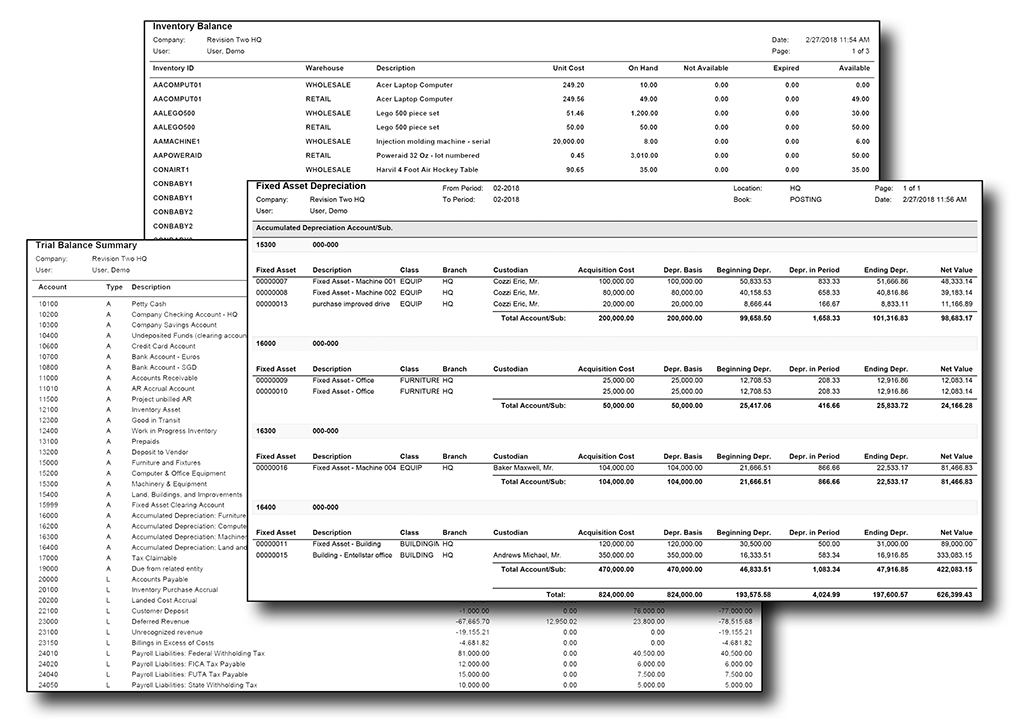Accelerate decision making with reporting tools that deliver customized views of your business overall and focused views of departments and functions.
How Acumatica ERP Reporting Can Work for You
ERP systems track all company transactions, such as sales, inventory, and company assets. Reporting functions within ERP systems access the raw information from the ERP database and present it in the form of reports containing actionable data so management can make informed decisions.
Each Acumatica module and suite comes with a full set of essential reports that can be used out-of-the-box to access real-time data from the system. Each report can be easily modified and new reports can be created using Acumatica’s Report Designer. Users can also create templates for commonly used report types.
Acumatica supports multi-dimensional reporting using subaccounts with segmented keys. Break down information into smaller facets to view items by price, color, size, store location, or any of a number of dimensions that you select. See the video, Dimensional Reporting Using Subaccounts.
With Reporting in Acumatica, you can:
- Schedule reports to run as needed.
- Generate signed PDF documents.
- Customize reports with your own branding and images.
- Create reports in real time, and apply filters as needed to get only the information you need now.
- Use Generic Inquiries to access data for your reports and then share that data with other applications for more analysis.
- Tailor report information by role.
With Acumatica, your reporting options are:
Benefits of Reporting and BI for your Business
-
Create customized reports
Generate custom reports when you need them and retrieve reports online to make better, faster, and more informed decisions. Create templates for commonly used report types.
-
Role-based reporting
Reports can be tailored to meet the information needs of all roles in your organization so sensitive information is only shared with the individuals with appropriate access.
-
Multiple reporting formats
Produce reports using HTML, PDF, Excel, or Word formats, so they can be easily shared with others, and automate report delivery over email.
-
Multi-dimensional reporting
Use subaccounts with segmented keys to break down information into smaller facets to view items by price, color, size, store location, or any of a number of dimensions that you select.
Important Features of Acumatica Reporting
Create visually-compelling reports including sales reports, check forms, invoices, and more. Easily design new reports or customize predefined reports with Acumatica Business Reports Designer.
Customize reports with your own branding and images, including full control over fonts and placement of information.
Easily create report templates by saving report parameters as a template and immediately populating reports with parameters from the template.
Apply ad hoc filters to entry forms and on report forms to display only the data you need at that moment.
Leverage reusable filters to create and apply complex filters, and save them for future use.
Toggle between parameters and views without losing changes made on the parameters view.
Register reports created in the report designer in Acumatica so they can be accessed from Acumatica menus.
Conveniently access reports, dashboards, and Generic Inquiries from secure mobile devices.
Allows users to preview a report and switch between Design and Preview mode at any time.
Create multiple reports and merge them into a single package before sending them as an HTML or PDF file.
Use business events to trigger email alerts, SMS text notifications, or tasks when conditions occur in the database that require user intervention or to keep teammates updated. Improve business event transparency by sending notifications about event activity to users who previously owned the event.
Use the Analytical Report Manager to build analytical reports that retrieve amounts posted to particular general ledger accounts and subaccounts. You can configure reports to display data for a company, company group, or branches of a company. Specify multiple, non-continuous ranges in the data source for accounts, subaccounts, and branches in the general ledger engine.
Acumatica Reporting Example



